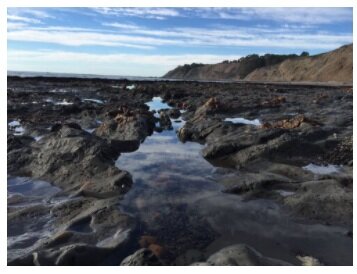The productivity, wildness, and beauty of California's coast and ocean are central to California's identity, heritage, and economy. In 1999, California passed the Marine Life Protection Act (MLPA) to create a network of interconnected Marine Protected Areas (MPAs) to protect the state's marine life and habitats; marine ecosystems and marine natural heritage; and to improve recreational, educational and study opportunities.
Throughout this process, EAC has been engaged as a stakeholder attending community planning meetings, coordinating with organizations, individuals, and government agencies to support the effort.
During the implementation of the MLPA, a new statewide community science program, MPA Watch, was launched to train community scientists to collect unbiased data on human activities in and near coastal and marine MPAs. MPA watch data is meant to inform the management, enforcement, and science of California’s MPAs and allow us to see how human uses are changing as a result of MPA implementation.
EAC launched our Marin MPA Watch program in 2013 in partnership with Point Reyes National Seashore and the California Academy of Sciences. We record data on consumptive and non-consumptive offshore and onshore activities in and around MPAs in Marin County that improves our understanding of how people are using these new MPAs. We conduct surveys from access points at Drakes Beach, Limantour Beach, Duxbury Reef, and the Corte Madera Marsh.
Since 2013, Marin MPA Watch has:
Collected more than 1,265 surveys
Trained 167 volunteers
Recorded more than 21,805 activities (consumptive and non-consumptive)
Provided 25 internships to high school and college students
Created a partnership with Marin County Parks and Open Space in 2018 and provided more than 100 students with intertidal ecology field experiences at Duxbury Reef State Marine Reserve.
2020 Impacts of the Pandemic and Woodward Wildfire
In March 2020, California under went a stay-at-home order that lasted through June 2020. The pandemic and stay-at-home order limited in the ways we could safely collect data, work with our volunteer community, and provide summer internships. This required that we adjust to the new programming challenges and activate our network of existing and previously trained volunteers to help us continue to collect data throughout the year.
On August 17, 2020, the Woodward Fire was ignited by a lightening strike in Point Reyes National Seashore. The wildfire resulted in evacuation warnings and evacuation notices throughout coastal areas of West Marin including Bolinas, Olema, and areas in Inverness. The lightening storm that ignited the Woodward Fire ignited 360 fires throughout the state,. According to Cal Fire, at the end of the year, nearly 10,000 fires had burned more than 4.2 million acres (or 4% of California land). The resulting smoke from the 360 fires burning in late August and through September affected air quality, making it difficult for people to recreate outside and reduced public visitation to MPAs and coastal areas.
CHALLENGES COLLECTING 2020 DATA
In order to keep the program functioning and collecting data throughout the year, we had to modify our program to meet the state and county safety guidelines, and ensure the health and safety of our our team members.
We asked our existing network of MPA volunteers if they would be willing to continue to collect data individually or with members of their same household through the end of the year. With the help of our online interns, we hosted an online training for our existing volunteers to review data collection protocols and answer questions they would encounter in the field. We also used this time to redesigned our MPA survey form (to save paper) and updated our website making it easier for our volunteers and the general public to learn about the MPA Watch program.
INCREASED VISITATION AND POACHING ISSUES
Fortunately, several of our volunteers helped to continue to collect data when state and county regulations allowed recreational access to parks and open space. Volunteers took on shifts to monitor the beaches.
We began receiving reports in July of unusually high visitation numbers at some of our more remote MPAs in Marin County. Along with the high number of visitors, we also were witnessing poaching activities in our intertidal areas. Specifically, our volunteers witnessed a spike in consumptive take (collecting of organisms) in the intertidal areas of Duxbury Reef.
However, Marin’s intertidal areas were not alone. Throughout the state, high visitation was increasing pressure on the fragile intertidal habitats. In Los Angeles County, the San Pedro tidepools experienced heavy collecting and harvesting that in September resulted in 45 people being charged with poaching, fishing without a license, and exceeding the daily limit. In San Mateo County, Bay Nature recently published an article about the pressure at Pillar Point and concerns of over harvesting.
Our MPA Watch volunteers documented many of these same problems at Duxbury Reef and their surveys and reports made it possible for EAC to raise the concerns to the California Department of Fish and Wildlife (CDFW) and the California Fish and Game Commission at the July and August. CDFW responded with increased public outreach, enforcement, and providing field presence to protect intertidal areas throughout the state.
In July and August, we coordinated with Point Reyes National Seashore and Marin County Parks and Open Space to provide a presence at low-tide to provide outreach and education to visitors.
During the King Tides in November we teamed up with CDFW to provide education on Duxbury Reef and were able to deter multiple groups seeking to harvest in the intertidal area in the parking lot and on the reef.
2020 RESULTS
Our 2020 report is now available for download and review and will be posted to the MPA Watch website along with all the other programs throughout the state. We have listed a snapshot of some of our results below. Please download the report to review the full details.
Limantour Beach (control site: point reyes/drakes beach)
This MPA recorded a use rate of 27.8 activities per miles surveyed. This is a 58% increase compared to the prior year rate. 99% of the observations in the MPA were on-shore non-consumptive. Dogs off leash continue to be an issue, volunteers recorded 65% of dogs on leash and 35% of dogs off leash.
Point Reyes State Marine Reserve (Drakes Bay)
This MPA recorded a use rate of 11.5 activities per miles surveyed. This was a decrease of 11% compared to the prior year rate. 94% of the observations in the MPA were mostly on-shore and offshore non-consumptive. Observations of dogs on Drakes Beach were less than the prior year.
Duxbury Reef (Agate Beach)
This MPA recorded a use rate of 29.4 activities per miles surveyed. This is an increase of 79% compared to the prior year. 11% of the observations in the MPA are on-shore consumptive. 305 incidents of hand collection of biota in the intertidal were observed in the months of June, July, and August 2020. Six observations (less than 1% of all activities) included off-shore consumptive uses (boat fishing in the MPA) and were reported to Fish and Wildlife. Dogs off leash continue to be an issue, 70% of dogs off leash and 30% of dogs on leash.
Note: Duxbury Reef SMR has the highest use count of all MPAs surveyed by Marin MPA Watch of 66% in one of the smallest survey areas. Duxbury Reef is a sensitive intertidal habitat where human impacts (trampling and collecting) may have long-term negative impacts to habitat and species.
Corte Madera State Marine Park (Corte Madera Marsh)
This State Marine Park recorded a use rate of 3 activities per miles surveyed. This is a 93% increase compared to the prior year. 100% of the activities were non-consumptive (97% on-shore and 3% offshore). Dogs are allowed on leash, volunteers recorded 62% on leash and 38% off-leash.
Corte Madera State Marine Park
Duxbury Reef State Marine Conservation Area
Limantour Beach (Control Site)
Point Reyes State Marine Reserve







